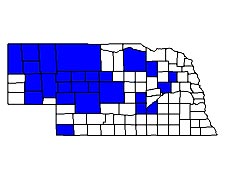
| Cicindela lengi lengi W. Horn |
| Adult Length: 12 to 16 mm |
| Appearance: Adults are coppery red with consistent maculation on the dorsal surface. All lunules are complete and connected by a continuous marginal band. The posthumeral mark is long and extends at an angle toward the posterior. The middle band is strongly bent. |
| Similar Species: This species is easily confused with C. formosa, but differs the posthumeral mark is longer and usually nearly twice as long as wide, whereas in C. formosa it is usually less than 1.5 times as long as wide. The middle band in C. lengi extends as much toward the posterior as from the marginal band, while in C. formosa it does not extend as much toward the posterior. It might also be confused with reddish individuals of C. tranquebarica from the southwestern corner of the state, but Nebraska specimens will rarely if ever have a complete marginal band. |
| Biology: This species occurs on sandy and loamy soils with sparse to scattered vegetation. Habitats include sand hills, sandy road banks, and other open sandy and loamy areas with sparse vegetation. It may sometimes occur on sandy clay soils. It is fairly skittish, but usually only flies about 5 to 10 meters when alarmed. |
| Adult Life History: Adults emerge from the pupa in August and September and are active until about early October before overwintering. Activity resumes in April and peak numbers occur in May and early June. Adults are scarce by early July. It is a spring-fall species. |
| Larval Life History: Eggs are laid mostly in April and May. The larval life history of the nominate subspecies has not been described. The other two subspecies require three years of larval development, but it is likely that the larval stages are completed in two years in most of Nebraska. |
| Biogeography: This species has been recorded from most of the counties in the Sandhills region of Nebraska as well as a few counties to the east and south. In North America it occurs from the far northeastern corner of Arizona and the Oklahoma panhandle region north through Wyoming and most of Kansas, Nebraska and the Dakotas to central British Columbia, and northern Alberta and Sakatchewan. Three subspecies have been described. |



